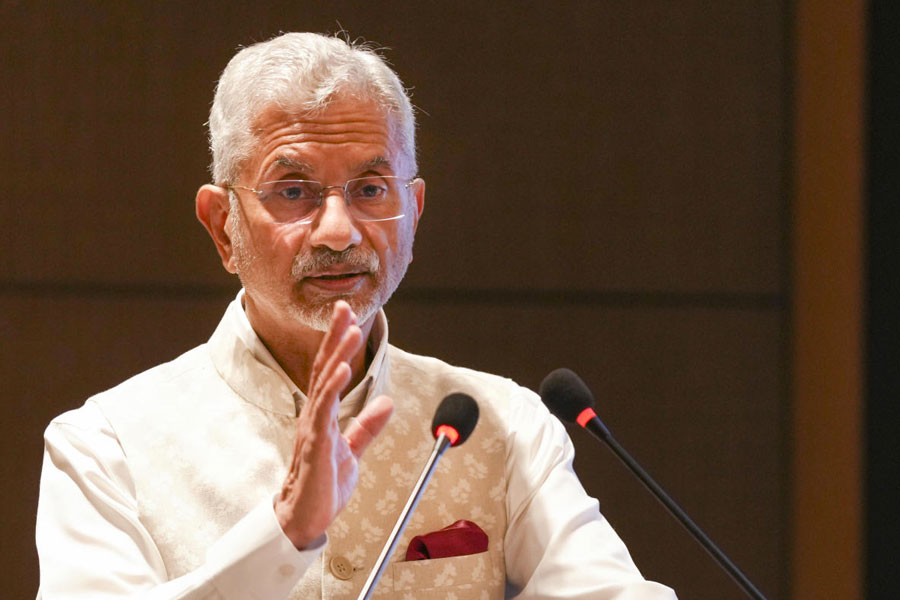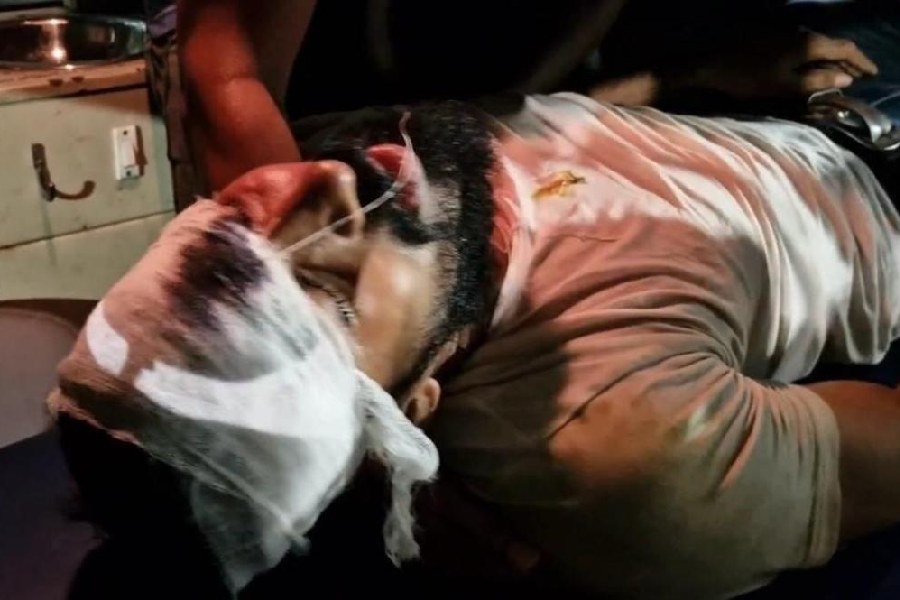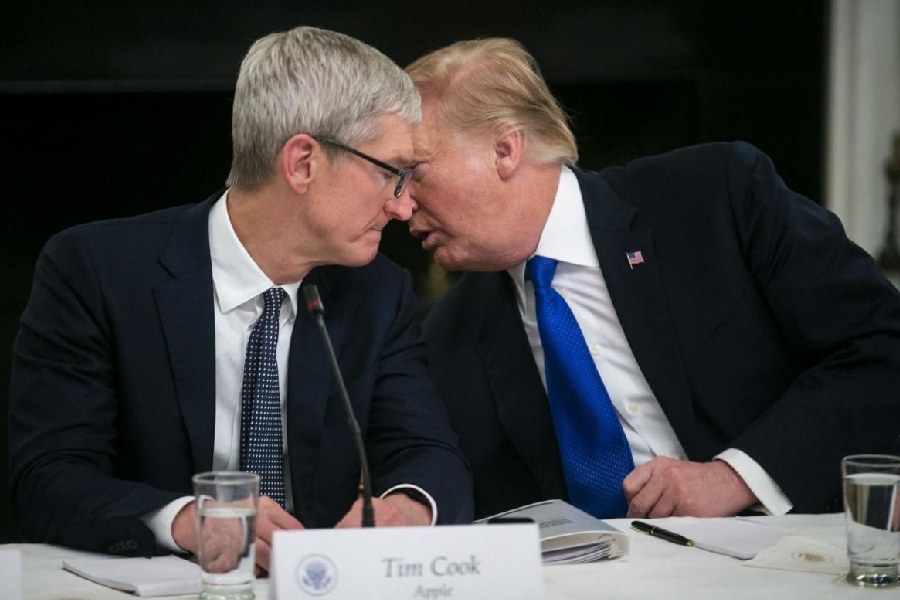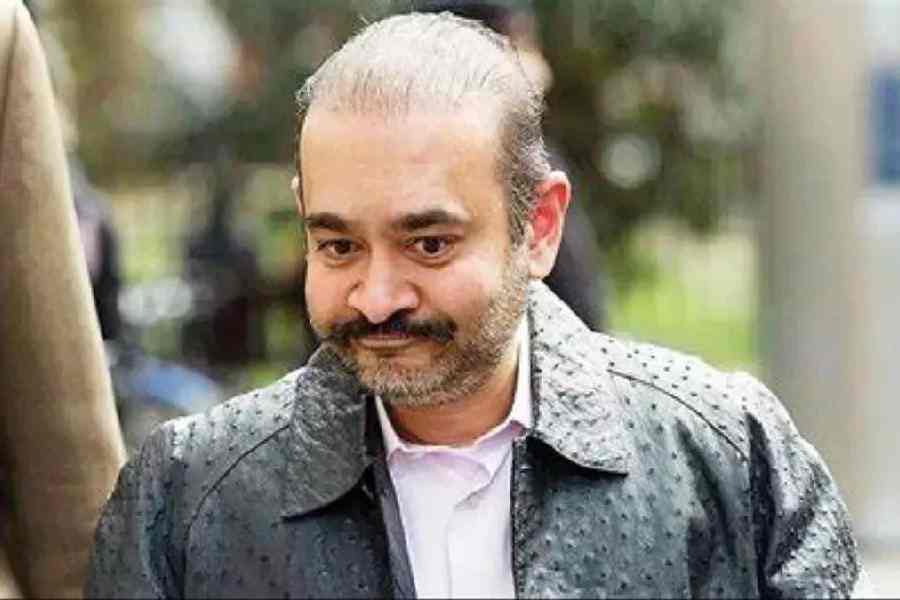 |
| Kalyan Ray and Aparna Sen at the t2 chat in Taj Bengal. Pictures: Pabitra Das |
You would wonder what kind of a house it is where two creative minds live, think, interact and write. “Our house is a factory of writing and cinema,” says Kalyan Ray, looking at his wife, filmmaker Aparna Sen, with smiling eyes as we wrap up a long adda about his new book, No Country — the 550-pager (published by Bloomsbury) that he wrote with a fountain pen over four years. t2 listened as the couple explored the book as well as their unique creative processes...
No Country covers a vast expanse of time and space, from the Irish famine of 1845 to the Jallianwala Bagh massacre to contemporary America and Calcutta...
Kalyan: Yes, it is about strands of different families coming together. It’s really about the friendship of two young boys in what was to become a very endangered Ireland. It’s about what happens with the children of one and the adopted child of another... and about how all these lives are intertwined with the lives of a particular family in Barisal. You see, all of them are displaced and caught in very large historical forces.
In the 15th and 16th centuries, we saw great naval explorations from the West. The 17th century saw the spread of colonialism. But the first experiment of colonialism by the English was in Ireland, and the second was in India. So, the history of being colonised in Ireland and in India are invisibly intertwined. For example, in the 1910s and ’20s, Indian patriots of what we call the Agni-Yug were inspired by the Irish rebellion, and Irish books, for example by Dan Breen which included instructions on how to make bombs. Yet, most of the British police officers in India were Irish, like Sir Charles Tegart. In the Indian police force, there were Anglo-Indian officers who were part-Irish and part-Indian. How could they not feel conflicted!
My novel covers the period of colonialism to its break-up, and its fateful impact on individual lives.
Though it’s a historical novel, No Country starts as a thriller...
Kalyan: I am not particularly interested in thrillers. But you need to hook the reader. So it starts with a murder and ends with a murder. But there has to be a transition. The Ahernes and the Mitras... the two families come together again at the end. It’s about how all of us are connected. Letters play a very important role in the novel. Letters of one age can reach another age. The connections are re-established.... I am not interested in detection, I am very interested in human motivation.
Where did the research for this book take you? How long did it take you to write it?
Kalyan: I immersed myself in four years of solid research. Then I did my best to make it read easily — as if it had no research. For six months before writing the Irish segment, I intentionally read nothing but Irish texts, newspapers and pamphlets of 1835-1845. I immersed myself in 1840s Ireland. At the outset I had wondered what right I had as an Indian, who lives partly in India and partly in America, to write about 19th century Ireland. And after my deliberate immersion — my spiritual training, so to speak — I concluded I had as much right as anyone living in Ireland today, because 19th century Ireland is as far away from him or her as it is from me. What I did have to do was earn it. And my research was my act of entry into that world.
Long back in the early1970s when I first went to America, I had stopped on the way and gone to Ireland. I wanted to see where WB Yeats was buried. He is buried in County Sligo (where a part of the book is set). I ran out of money and I had the choice of coming back quickly or spending 10 more days, but I would have to walk from County Sligo to Dublin, and I walked. That is the journey that Padraig Aherne (one of the two protagonists in No Country) takes, from County Sligo to Dublin, about a hundred miles. So, nothing was wasted!
Rinadi, do you see yourself turning No Country or some of its characters into film?
Aparna: The book is a saga. If one were to do justice to it, one would have to make it into two films at least.... But if Midnight’s Children can be filmed, so can this I suppose! It would require tremendous amount of resources and a very gifted scriptwriter. I can see it as a film in three parts, like The Godfather. (Smiles)
What’s your favourite part of the book?
Aparna: Oh there are many.... I love Maire Aherne and her seduction by Lord Palmerston. I am deeply agitated by the fire that takes place in the clothes factory.... And I love the part where Padraig reaches India. He comes across Charaker mela in Barisal and finds the boy Ramkumar — an episode which is tied up later in the novel.
Kalyanda, did you want to write about this period, or did you have the characters in mind and found a historical backdrop for them?
Kalyan: You know what’s interesting, one of my favourite poets is William Butler Yeats.
Aparna: Mine too...
 |
Kalyan: That’s how we met.... The first time we met we were quoting Yeats to each other and I thought that was amazing.... I was interested in Irish poetry, in Irish politics.... I should have studied history, not English. Anyway, what put it together were a number of images in my head. I had read how the famine ships were going and one of the ships floundered on an iceberg. Another incident was when a ship had to be abandoned and the captain with some crew members abandoned the hapless passengers. I put together these elements of real incidents. One of the images that came to me was of the old schoolmaster on his chair on the iceberg. The other was of a madwoman nursing her odd-looking child in Bhowanipore, which I had seen, and which transposed itself onto Ireland and became Odd Madgy Finn. She is one of my absolute favourite characters. Madgy Finn becomes symbolic of Ireland.
Aparna: It also happens in cinema.... I know that for Paroma, I had the image of this archetypal adulteress with shorn head first in my head, the story came later. Often the images come earlier, in literature as well as in cinema. I create stories with images, and Kalyan creates images through his words. (Smiles)
Kalyan: Filmmaking is the art of the possible. Thank god, we don’t have to deal with producers and distributors!
Aparna: But you have editors!
Kalyan: Yes! (Laughs)
Aparna: You had a good one.
Kalyan: Yes, I had... Rina has been incredibly supportive. I always thought of myself as an academic, and when I used to tell her these stories, she used to say, why don’t you write them?
Apart from encouragement, how else has she been supportive?
Kalyan: Well, by putting up with my considerable absentmindedness! Rina is also my first reader...
Aparna: ...and critic.
Kalyan: A very hard critic. (Aparna laughs) She does not spare anyone. Rina’s criticism is direct and...
Aparna: Brutal! (Both laugh) Konkona’s favourite phrase is, “Ma and her brutal frankness!”
Rinadi, do you get the same kind of support from him?
Aparna: Yes, he has been very supportive. I always read my scripts to him.... The first thing he knew about me was my cinema. Before he met me, he met my cinema...
Kalyan: It’s very funny! I was at a party in America, a whole bunch of immigrant Bengalis were there, and somebody said that there’s an interesting film called 36 Chowringhee Lane.... Now I hadn’t come to India for about 11 years.... When I heard about it, I watched it on VHS from beginning to end, absolutely mugdho hoye.... Years later when I met her, I had no idea that she was such a huge star. And when we got married and arrived at Dum Dum airport and saw the mad rush of photographers — oh, that was a culture shock!
Aparna: Well, he knew, but did not know the ramifications of it...
Kalyan: I was very taken by this woman who knew her Yeats! (Aparna laughs) We got married in the US after knowing each other for barely three weeks. But when I met my father-in-law (Chidananda Dasgupta), I felt completely at home. (Smiles)
Aparna: Actually, he married me only because I was Chidananda Dasgupta’s daughter and Jibanananda Das’s niece!
Kalyan: (Laughs) Yes, she does not make a big deal about it.
Aparna: (Laughs) My mother was his first cousin. We used to call him Milu Mama. He used to come over to our house. We used to find him very strange, and he looked very strange too.... Because our parents loved his poetry so much, we started reading Jibanananda when we were very young.
Kalyan: And there is striking similarity between Yeats and Jibanananda Das’s works.
Aparna: Oh my god, yes! What a tremendous similarity between Yeats’s The Second Coming and Jibanananda’s Adbhut andhaar ek eshechhe e prithibite aaj.
Kalyan: ‘No Country’ is a phrase from Yeats’s Sailing to Byzantium. The epigraphs of all the sections in the book are taken from that poem.
There’s a Brother Brendan MacCarthaigh in Calcutta. And one of the two main characters in No Country is named Brendan MacCarthaigh...
Kalyan: I took his name deliberately! I had met Brother Brendan when I used to bring groups of American students to study Indian literature in translation and Indian history. I had liked his name. But there is no similarity between him and the character in the book... Also, there was St Brendan of Ireland, who goes on voyages (like Brendan in No Country).
Aparna: Tell her how you got the idea of Papa Brendan... (Smiles)
Kalyan: (Smiling) You tell her...
Aparna: Well, after I married him, Konkona was very frightened when I told her about it over the phone. She said, “Will you be living there?” I said, “Of course not. How can I live without you?” She was very relieved at that and said, “Well, then you have my blessings”!
Kalyan: (Laughs) She was all of 11-12...
Aparna: And when we came back, she started calling him Kalyan Baba! On her own. Nobody had taught her to say that.
Kalyan: That’s how Maeve calls Brendan. Papa Brendan....
Do the characters in No Country have shades of people you have known personally?
Kalyan: There’s a shade of my father-in-law in the character of the schoolteacher Mr O’Flaherty, as well as of one of my teachers, Father Guy Carlson. Josephine Grunwald is based on an aunt of one of my close American friends. But I have never met anyone like Maire Aherne. Red-haired, a great beauty, quick to anger but very large-hearted. If I had met someone like her, maybe I would have fallen in love with her! Since the book is rooted in history, a lot of them are historical characters, like Lord Palmerston, who seduced Maire Aherne and later became the Prime Minister of England. I have added Violet Stoneham for a bit of fun (laughs), from 36 Chowringhee Lane...
Aparna: (Laughs) Just the name...
Kalyan:...as if Padraig knew her. Then there’s Calcutta of the Sixties, I have included Nondon Bagchi, Lew Hilt, Amyt Datta, Anjan Dutt.
Aparna: You have also included the Hollywood actress Merle Oberon...
Kalyan: Yes... Merle Oberon studied at La Martiniere and performed at Calcutta Amateur Dramatic Society’s A Midsummer Night’s Dream. Her original name was Estelle...
Aparna: And you have kept that name in the book...
Kalyan: Yes, Estelle... whom Robert knew... Merle Oberon always maintained that she was born in Tasmania, which was a total lie! She didn’t want to be known as an Anglo-Indian. She would always be accompanied by her mother, whom she would introduce as her maid.
Aparna: Oh! Like Saptapadi!
Kalyan: Yes, like Rina Brown....
How many characters would you say there are in the novel?
Kalyan: Oh, I have not counted! (Smiles. Aparna laughs) The book was advertised in America as ‘Three continents, two centuries, one novel’. So, there! There are about 10 main voices, all of them are first-person narratives....
Both of you are pulled towards the Anglo-Indian community, their predicament...
Aparna: I feel drawn to old people... I have always felt that they are lonely; people don’t pay them any attention; they are marginalised. And I have an interest in marginalised characters. I wanted to write 36 Chowringhee Lane from felt experience. Even Miss Stoneham has shades of some Anglo-Indian schoolteachers of mine.
How are your creative processes different?
Kalyan: Completely different.
Aparna: Completely different though we share a lot with each other. But he writes alone. As for me, I am a storyteller. When my mother was alive, it was lovely because she always had time for me. I used to tell her stories. I also used to tell stories to my brother-in-law... Monojit (Lahiri). He was my friend before he became my brother-in-law. As I told the stories, the details grew. Later when I wouldn’t be there, my sister used to keep him company, and that’s how their love affair started and they got married! Even now as I tell stories to my friends, Jayashree (Dasgupta) or Sohag (Sen), the details of the story grow. But there is one similarity between Kalyan and me, and that is that both of us see a lot of images as we create.
Kalyan: As a matter of fact, the night before we got married, Rina read out the whole script of Yugant to me. You remember?
Aparna: (Nods) I didn’t think it would ever get made!
Rinadi, what’s your writing process?
Aparna: I used to go to Santiniketan when my parents were alive. I would wake up in the morning, have tea and adda with my parents, then go and sit out in the garden and write... usually in winter.... Then I would be back around 11.30am, have coffee and snacks with them and return to my writing. Then we’d all have lunch together and I would go to my room and write while they rested. There was a routine to the whole thing....
I still write in Santiniketan. I had gone there to write a script after my mother passed away. I thought of writing at my mother’s desk and when I sat down and opened the drawer, I found it was completely empty. I remembered that I had sorted the papers and cleaned the desk the last time I had come, and the desk felt so denuded that I broke down. I thought what right did I have to strip my mother’s desk of her memory? But I still do write there. The problem is, if Kalyan and I go to Santiniketan together, we end up chatting so much...
Kalyan: But it also happens that you are writing and I am reading, a kind of companionable state...
Aparna: Not so much anymore because I live here, he lives in the US. And when he comes back...
Kalyan: Addar catch-up hoy....
Aparna: Or we are watching TV and fighting over which channel to see. He can watch cricket day and night! I like to watch news channels.
Kalyan: Look, cricket is a way of life. And in America, I am starved of cricket!
Kalyanda, you said you’re like a “pressure cooker” when you are writing...
Kalyan: I am like an animal. I go into a corner. Rina has built me a very beautiful, large room with a great view. (Aparna laughs) But I can’t write there. I need to be cooped up in a small room.... Once I had written a 40-page story in Bengali — Tarashayarer Ma which came out in Sharadiya Desh — sitting on a culvert in Santiniketan. It was summer and very hot. I bought some paper and just started writing....
Aparna: Yes, sometimes you are possessed! And some of your best writing comes in that state. You know, a lot of people write their screenplays in a planned way. I start out usually with images. I start writing and something inside me tells me that now this has to happen. When that inspired writing happens, you can’t write as fast as you are thinking! I remember when writing 36 Chowringhee Lane, I asked myself, what was the greatest tragedy of the Anglo-Indians and realised that it was the leaving of the British. No matter what the British thought of them, the Anglo-Indians thought of England as home. I was in my parents’ Delhi home and I remember I could not write fast enough because my mind was racing faster! I wrote the sequence of Eddie suffering from dementia and talking of writing a letter of complaint to King George, and Miss Stoneham telling him that the Raj was over.
Kalyan: This is what happens in No Country too. Robert has to choose sides. And he talks about how his community tried to forget their Indian heritage. At one point of time, it mattered a lot to Anglo-Indians just how close they were to the British, or how fair their complexion was...
What are your favourite historical novels?
Aparna: I loved Tariq Ali’s Islam Quintet. And both Konkona and I loved Naguib Mahfouz’s Cairo Trilogy, especially Palace Walk. I also love Sharadindu Bandopadhyay’s historical novels like Kaaler Mondira and Tungabhadra’r Teerey. For me, they’re comfort food for the soul!
Kalyan: As far as “historical” novels go, the masters are Tolstoy and Pasternak. But history is used in fascinating ways by Hugo, Balzac, Lampedusa, and in Bengal by Bankim and Sharadindu. In any case, I am keenly interested in history. My professor Amal Bhattacharji introduced me to Herodotus, and I have been addicted ever since. And, oh yes, Mahabharat... the greatest work of fiction.
Aparna: Yes, I too love the Mahabarat. Mahabharater Sarangsho, written by Rajshekhar Basu....
Kalyan: I was profoundly influenced by Thomas Hardy’s tragic vision of human destiny. The fact that one didn’t get a letter and that changes the course of one’s destiny. That is what happens in life!
Aparna: What are your favourite Thomas Hardy novels?
Kalyan: Jude the Obscure, The Mayor of Casterbridge, Tess of d’Urbervilles.
Aparna: The Mayor of Casterbridge is wonderful....
As creators of films and novels, do you feel you are always in control of your characters, or do they take control of you?
Aparna: You know, after a point, the characters take on a life of their own and I am no longer in control....
Kalyan: If they come to life, they start taking control.
Aparna: Miss Stoneham was supposed to go away to Australia in 36 Chowringhee Lane you know, but I just couldn’t make her go! Sometimes the characters you have created start taking their own decisions. And that is a very organic process. You know, reaffirmation of life is a natural instinct with me. Maybe because of my Brahmo upbringing, the Upanishads...
Kalyan: I too believe in it, reaffirmation of life, a transcendence.
Aparna: Take for instance that song Bipulo tarongo re in Paromitar Ek Din. It came to me instinctively as I was writing my screenplay. That girl Khuku (played by Sohini Sengupta) — at one stage she started doing things on her own. When she opens the door for Soumitra (Chatterjee) one afternoon, she starts chatting with him and offers him muri very graciously. And in the same scene she asks Soumitra, “Shudhu amari mathar asukh achhe?” while we hear reports of bombings in Bombay coming in on the radio. I love these contradictions! And they come organically into my work, I can’t do these things deliberately.
Kalyan: I was in a fix about how to end the novel and then I came across a news report of a real double murder in Upstate New York of an Indian couple. And I felt, this is it! This is a classic device of storytelling which we find in William Faulkner, and everything is illuminated by the time we come back to the beginning.
To go back to the beginning, No Country starts with an intriguing dedication — For daughters, lost and found...
Kalyan: Well, the clues are there in the book. Padraig loses his daughter and Brendan gets a daughter. Also, there are are many women’s voices.... In my case, daughters found are Konkona and Dona. (Smiles)










